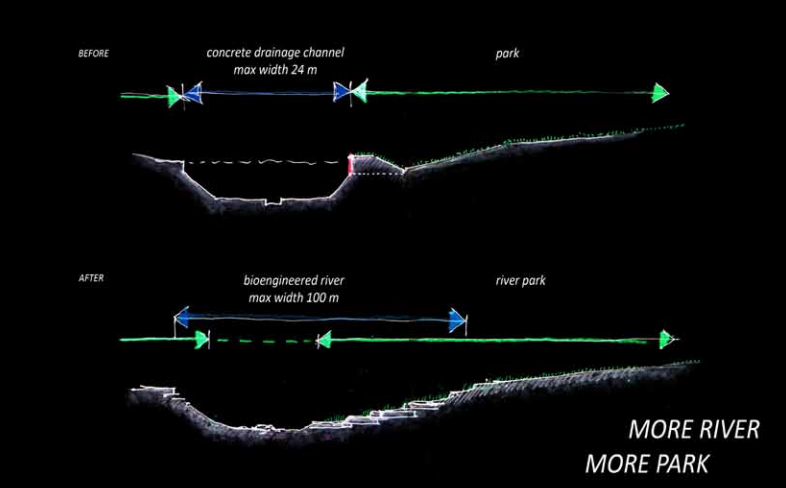Coping with floods in Singapore
Bishan-Ang Mo Kio Park was one of the places flooded from the heavy downpour on 1st Jan 2021.
The 3.2km meandering naturalised river at Bishan-Ang Mo Kio Park used to be a 2.7km long straight concrete Kallang channel in the past, which would not otherwise have been able to contain as much rainwater as it now does.
The video below shows the amazing transformation of Bishan-Ang Mo Kio Park.
The 3.2km meandering naturalised river at Bishan-Ang Mo Kio Park used to be a 2.7km long straight concrete Kallang channel in the past, which would not otherwise have been able to contain as much rainwater as it now does.
Picture from Ramboll Studio Dreiseitl
Source: https://mothership.sg/2021/01/bishan-ang-mo-kio-park-flooded/
The river channel was redesigned to resemble a floodplain that connects to a network of drains in town. It is flooded during extreme wet weather
The usual volume of water will form only a narrow stream in the middle of the river while the adjacent area doubles up as a conveyance channel to dissipate large amounts of rainwater downstream in the event of a storm. After the redevelopment, the naturalised river's carrying capacity increased by 40 per cent, with an increase in length from 2.7km to 3.2km, as well as an increase in width by almost five times.
"Flooding" of Bishan-Ang Kio Park 1 Jan 2020
PUB has issued flood risk warnings for several locations including Lorong Halus, Pasir Ris Farmway 3, Jalan Seaview, Mountbatten Road and the junction of Bedok Road and Upper Changi Road East, as the heavy rain from 1st to 2nd Jan 2021 haa caused water levels in the drains and canals to exceed 90% capacity.
PUB’s Quick Response Teams were deployed to direct traffic and render assistance to residents in the areas stated above to protect them from flood risk. For example, officers helped residents in Mountbatten and Jalan Seaview to install inflatable flood bags to protect their homes.
The highest total amount of rainfall since 1 Jan 2021 (as at noon on 2 Jan 2021) recorded at Changi was 318.6mm, which is more than the equivalent of the average monthly rainfall for January (238.3mm).
The heaviest rainfall of 184.4mm was also recorded at Changi on 2 Jan from 12am to noon. This amount is more than half of Singapore's average monthly rainfall in January, and lies within the top 1 per cent of maximum daily rainfall records for the past 39 years.
Source: https://m.facebook.com/story.php?story_fbid=3540978622659460&id=109647569125933
Check out the new flood protection barrier, Floodgate, which can be quickly deployed to protect homes and buildings in the event of a flash flood. It is made from high-strength steel frames wrapped in a waterproof rubber sleeve which is expandable and can be installed at the entrances of residential, commercial and industrial premises.
Why does Singapore experience greater amounted of rainfall in Dec and Jan?
How does flash flood occur?
Where are the areas most affected by flash floods?
What are the measures taken to mitigate the impacts of flood?






0 Response to "Coping with floods in Singapore"
Post a Comment